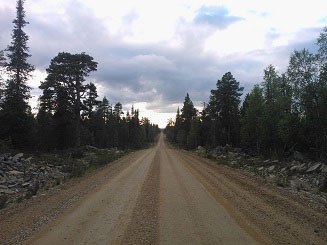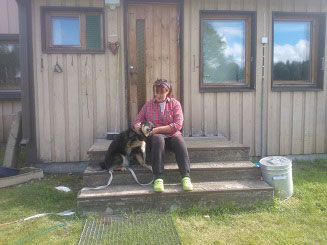August has started and here in Upper Lapland it is a late summer month. Most of us have experienced this summer longer than usually, just because it was awfully warm already in May. This has been a good summer, our pied flycatcher nested twice, there have been a lot of cloudberries and big juicy blue berries, and eventually it looks like lingonberry harvest will be excellent. This has been a good summer for mosquitoes, too. Polttiaiset, as we call those little flies appearing at the end of the summer are occupying our river banks in the evenings and at the moment it is a pain to fish. I am waiting for salmon trout to rise for upper stream; there should be a good catch by the end of this month. Reindeer is in the forest after the mushroom.
 My home is in Kuttura, which is by the upper stream of Ivalo River and by the dead end of the dust road of 40 km from the main road. This is one of the last wilderness villages in Finnish Lapland. Summer is an intensive season for all of us. Because Kuttura is a faraway place, relatives and other friends come to visit us for days. This village doubles its population during summertime – many of original Kuttura people have their summer cottages here and in the summer time there are 12 houses inhabited but only seven houses have “smokes” throughout the year. Actually, summer keeps us so busy, that we permanent neighbours hardly see each other during summer months.
My home is in Kuttura, which is by the upper stream of Ivalo River and by the dead end of the dust road of 40 km from the main road. This is one of the last wilderness villages in Finnish Lapland. Summer is an intensive season for all of us. Because Kuttura is a faraway place, relatives and other friends come to visit us for days. This village doubles its population during summertime – many of original Kuttura people have their summer cottages here and in the summer time there are 12 houses inhabited but only seven houses have “smokes” throughout the year. Actually, summer keeps us so busy, that we permanent neighbours hardly see each other during summer months.
In a photo below I am sitting on our steps by our font door. The nearby houses are now quiet – Magga relatives have gone back to towns. Still, summer birds like the northern house martin is flying around. How do I feel, is our village getting quiet with less people? No, I do not think like that at all. I am getting ready for the autumn tasks and for coming winter. These seasons in front of us will be full of action and social life, too. Once the summer birds disappear, the winter forest birds come to stay with us during those mid-day hours of day light. Last winter beside reindeer, we had three moose visiting us now and then, and quite many baby foxes used to come to eat our dog’s food. Reindeer work starts and there will be “home reindeer” moving around the village. Winter fishing activities will start, too. Beside the social life with forest animals, we start to visit each other’s on daily bases.
 However, living in the wilderness is not ruling out my academic life. The good internet connection enables me to keep in connection with research community. A while ago I found RG and Academia Edu. This opened up a new world of interesting conversations. When I am in my office, I work just as anyone else in universities or research institutions. Once I look from my window – instead of being surrounded by city traffic the wildlife traffic keeps a hold on me. As an anthropologist, I respect this, the wilderness e.g. the seasonal wildlife connected to practical tasks/work enables me to evaluate my discipline and academic arguments from unique perspectives.
However, living in the wilderness is not ruling out my academic life. The good internet connection enables me to keep in connection with research community. A while ago I found RG and Academia Edu. This opened up a new world of interesting conversations. When I am in my office, I work just as anyone else in universities or research institutions. Once I look from my window – instead of being surrounded by city traffic the wildlife traffic keeps a hold on me. As an anthropologist, I respect this, the wilderness e.g. the seasonal wildlife connected to practical tasks/work enables me to evaluate my discipline and academic arguments from unique perspectives.
I want to make a short anthropological visual comment on sustainability. You can see some kind of junk in the last photo – there is a part of an old mattress and tarps. Being in the wilderness and being ready for winter, one never knows when you might need these things. My husband loves to say: “For others abandoned things are junk, but there are days when forest people might need somehing that is not there. Then an anonym junk gets its new shape and new name.” Our old broken children’s sledge (junk), for example, became to be a transported fire place during winter fishing season.
Text by Terhi Vuojala-Magga